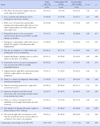Abstract
Purpose
The purpose of this study was to investigate the contraceptive knowledge and practice among married immigrant women.
Methods
A cross-sectional survey design with a convenient sampling was used. 170 married immigrant women were recruited in Daejeon city and Chungcheong area. A structured questionnaire was self-administered from November 1, 2011 to January 13, 2012.
Results
48.2% of subjects have used contraceptive practice. The widely used contraception methods were IUD, condom, oral pill and withdrawal. 73.2% of subjects got information about contraception from family and friends, and 18.3% of subjects had no source of information. The subjects' employment state (p = .006), duration of marriage (p = .019), number of baby (p = .021), family type (p = .046) have a significant influence on their contraceptive practice. The subjects' mean score of contraceptive knowledge was very low (5.72 points out of 15 points). There were significant differences in subjects' contraceptive knowledge depending on their education level (p = .002), employment state (p < .001), country of origin (p = .010), and family type (p = .003).
Conclusion
To improve contraceptive knowledge and practice for married immigrant women, it is necessary to develop a proper contraceptive education program to enhance contraceptive knowledge and practice. Adjusted education program by this results will contribute to increase sexual health for married immigrant women.
Figures and Tables
References
1. Ahn YH. Health status and health behavior of immigrant women married to koreans. J Korean Acad Public Health Nurs. 2008. 22:18–26.
2. Bensyl DM, Iuliano DA, Carter M, Santelli J, Gilbert BC. Contraceptive use united states and territories, behavioral risk factor surveillance system, 2002. MMWR Surveill Summ. 2005. 54(6):1–72.
3. Calabretto H. Emergency contraception - knowledge and attitudes in a group of australian university students. Aust N Z J Public Health. 2009. 33(3):234–239. http://dx.doi.org/10.1111/j.1753-6405.2009.00381.x.

4. Choi JH, Kim KE, Shin MA. Contraceptive knowledge, contraceptive attitude, and contraceptive use among college students: Function of gender, age, and residence. Korean J Hum Ecol. 2010. 19(3):511–522.

5. Choi SY, Kim YH, Oh HS. A study on sexual behavior, pregnancy and contraception knowledge in female adolescent. Korean J Women Health Nurs. 2004. 10(1):42–50.

6. Chung CS. Pregnancy, delivery and cultural integration of international marriage migrant women. 2011. Busan: Inje University;Unpublished doctoral dissertation.
7. Dinh Thi TH. The factors affecting knowledge of source for condom in vietnam 2005. In : 3rd International Conference on Reproductive Health and Social Science Research; 169–184.
8. Gorbach PM, Hoa DT, Nhan VQ, Tsui A. Contraception and abortion in two vietnamese communes. Am J Public Health. 1998. 88(4):660–663.

9. Jeong GH, Koh HJ, Kim KS, Kim SH, Kim JH, Park HS, et al. A survey on health management of during pregnancy, childbirth, and the postpartum of immigrant women in a multi-cultural family. Korean J Women Health Nurs. 2009. 15(4):261–269. http://dx.doi.org/10.4069/kjwhn.2009.15.4.261.

10. Kim DH, Park HS, Bae KE. Obstetrical & gynecological health status and body composition of married immigrant women in Pusan. J Life Sci. 2010. 20(6):894–901.
11. Kim HJ. Cross-border marriages between vietnamese women and Korean men: The reality and problems(a view from vietnam). East Asian Stud. 2007. 52:219–254.
12. Kim HR. Maternal health and nutritional status of marriage-based women immigrants in Korea and policy directions. Health Welf Policy Forum. 2009. 155:50–64.
13. Kim HR, Hwang NM, Chang IS, Yoon KJ, Kang BJ. The reproductive health and policy subject in the international foreign wives. 2008. Seoul: Korea Institute for Health and Social Affairs.
14. Kim HS. Internal marriage migrant women in korea. Korean J Women Health Nurs. 2008. 14(4):248–256. http://dx.doi.org/10.4069/kjwhn.2008.14.4.248.
15. Kim MJ. A structural equation model explaining contraception behaviors of married Korean women. 2001. Seoul: Yonsei University;Unpublished doctoral dissertation.
16. Kim MJ, Kang HS. A comparative study of consistent and inconsistent contraceptive users on partner communication, perceived contraceptive control, and sexual autonomy. J Korean Acad Nurs. 2003. 33(6):784–791.

17. Kim MJ, Kim TI, Kwon YJ. A study on health promotion behavior and contraception in married immigrant women. Korean J Women Health Nurs. 2008. 14(4):323–332. http://dx.doi.org/10.4069/kjwhn.2008.14.4.323.

18. Kim SK, Cho AJ, Kim YK, Do SR, Lee KW. The survey on the national fertility, family health and welfare in Korea. 2006. KIHASA.
19. Kim YA, Oh JA. Knowledge and attitude of high school girls on the contraception and induced abortion. Korean Parent Child Health J. 2011. 14(1):9–17.
20. Klingberg-Allvin M, Binh N, Johansson A, Berggren V. One foot wet and one foot dry: Transition into motherhood among married adolescent women in rural vietnam. J Transcult Nurs. 2008. 19(4):338–346.
21. Knodel J, Phan TA, Truong VD, Dao XV. Why is oral contraceptive use in vietnam so low. Int Perspect Sex Reprod Health. 1995. 21(1):11–18.

22. KOSIS. The statistics of population of multiculture families in Korea. 2011. Retrieved January 10, 2012. from http://kostat.go.kr/portal/korea/kor_nw/2/1/index.board?bmode=read&aSeq=251920.
23. Lee HN, Byeon YJ. Contraceptive practice and attitudes in Chungju Korea. Korean J Obstet Gynecol. 2003. 46(4):738–745.
24. Park GJ. Korean women's contraceptive status and up-to-date methods of contraception. Korean Society of Obstetrics and Gynecology, Educational lectures. 2002. 163–177.
25. Park HS, Bae KE, Kim DH, Yoon AR. Health status of married immigrant women in Pusan. J Korean Acad Fundam Nurs. 2008. 15(1):80–88.
26. Seol DH. Child raising and education of marriage-based immigrants in Korea: On the focus of infants. Korean J Pediatr. 2009. 52(4):403–409. http://dx.doi.org/10.3345/kjp.2009.52.4.403.

27. Seol DH, Lee HK, Cho SN. Survey on marriage family and strategy for their long-term support. 2006. Seoul: Ministry of Gender Equality & Family.
28. Schoemaker J. Contraceptive use among the poor in indonesia. Int Fam Plan Perspect. 2005. 31(3):106–114.

29. Wang RH, Wang HH, Hsu MT. Factors associated with adolescent pregnancy-a sample of taiwanese female adolescents. Public Health Nurs. 2003. 20(1):33–41.
30. Yoon YO, Moon IO. Associated factors on reproductive health of vietnamese female immigrants: Application of PRECEDE model. Korean J Health Educ Promot. 2010. 27(4):61–72.




 PDF
PDF ePub
ePub Citation
Citation Print
Print






 XML Download
XML Download